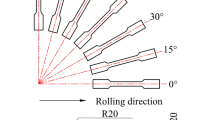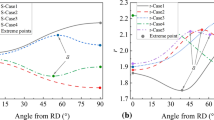Abstract
In the present work, a modified version of the widely used Yld2000-2d yield function and its implementation into the commercial FE-code LS-Dyna is presented. The difference to the standard formulation lies in the dependency of the function parameters on the equivalent plastic strain. Furthermore, strain rate dependency is incorporated. After a detailed description of the model and the identification of the parameters, the numerical implementation i.e., the stress-update algorithm used for the implementation is explained. In order to validate the model, two different materials, namely Formalex™5x, a 5182-based aluminum alloy and a DC05 mild steel were characterized. The results of the tensile and hydraulic bulge tests are presented and used for the parameter identification. The experimental curves are reproduced by means of one element tests using the standard and modified model to demonstrate the benefit of the modifications. For validation purposes, cross die geometries were drawn with both materials. The outer surface strains were measured with an optical measurement system. The measured major and minor strains were compared to the results of simulations using the standard and the modified Yld2000-2d model. A significant improvement in prediction accuracy has been demonstrated.






















Similar content being viewed by others
References
Kuwabara T (2007) Advances in experiments on metal sheets and tubes in support of constitutive modeling and forming simulations. Int J Plasticity 23(3):385–419
Hill R (1948) A theory of the yielding and plastic flow of anisotropic metals. P Roy Soc Lond A Mat 193(1033):281–297
Hill R (1979) Theoretical plasticity of textured aggregates. Math Proc Cambridge 85(01):179–191
Hill R (1990) Constitutive modelling of orthotropic plasticity in sheet metals. J Mech Phys Solids 38(3):405–417
Barlat F, Lian K (1989) Plastic behavior and stretchability of sheet metals. Part I:A yield function for orthotropic sheets under plane stress conditions. Int J Plasticity 5(1):51–66
Barlat F, Lege DJ, Brem JC (1991) A six-component yield function for anisotropic materials. Int J Plasticity 7(7):693–712
Barlat F, Maeda Y, Chung K, Yanagawa M, Brem J, Hayashida Y, Lege D, Matsui K, Murtha S, Hattori S, Becker R, Makosey S (1997) Yield function development for aluminum alloy sheets. J Mech Phys Solids 45(1112):1727–1763
Barlat F, Brem J, Yoon J, Chung K, Dick R, Lege D, Pourboghrat F, Choi SH, Chu E (2003) Plane stress yield function for aluminum alloy sheetsPart 1:theory. Int J Plasticity 19(9):1297–1319
Banabic D, Kuwabara T, Balan T, Comsa D, Julean D (2003) Non-quadratic yield criterion for orthotropic sheet metals under plane-stress conditions. Int J Mech Sci 45(5):797–811
Banabic D, Aretz H, Comsa D, Paraianu L (2005) An improved analytical description of orthotropy in metallic sheets. Int J Plasticity 21(3):493–512
Cazacu O, Plunkett B, Barlat F (2006) Orthotropic yield criterion for hexagonal closed packed metals. Int J Plasticity 22(7):1171–1194
Chaboche J (1989) Constitutive equations for cyclic plasticity and cyclic viscoplasticity. Int J Plasticity 5(3):247–302
Yoshida F, Uemori T, Fujiwara K (2002) Elasticplastic behavior of steel sheets under in-plane cyclic tensioncompression at large strain. Int J Plasticity 18(56):633–659
Aretz H (2008) A simple isotropic-distortional hardening model and its application in elasticplastic analysis of localized necking in orthotropic sheet metals. Int J Plasticity 24(9):1457–1480
Barlat F, Gracio JJ, Lee MG, Rauch EF, Vincze G (2011) An alternative to kinematic hardening in classical plasticity. Int J Plasticity 27(9):1309–1327
Hu W (2007) Constitutive modeling of orthotropic sheet metals by presenting hardening-induced anisotropy. Int J Plasticity 23(4):620–639
Lopes A, Barlat F, Gracio J, Ferreira Duarte J, Rauch E (2003) Effect of texture and microstructure on strain hardening anisotropy for aluminum deformed in uniaxial tension and simple shear. Int J Plasticity 19(1):1–22
Hora P, Hochholdinger B, Mutrux A, Tong L (2009) Modeling of anisoptropic hardening behavior based on Barlat 2000 Yield Locus Description. In: Proceedings 3rd formation technical forum Zurich 2009 (Zu̇rich), Switzerland. Institute of Virtual Manufacturing, Zu̇rich, pp 21–29
Wang H, Wan M, Wu X, Yan Y (2009) The equivalent plastic strain-dependent yld2000-2d yield function and the experimental verification. Comp Mater Sci 47(1):12–22
Hershey A (1954) The elasticity of an isotropic aggregate of anisotropic cubic crystals. J Appl Mech 21(3):226–240
Hosford WF (1972) A generalized isotropic yield criterion. J Appl Mech 39(2):607
Logan RW, Hosford WF (1980) Upper-bound anisotropic yield locus calculations assuming 111-pencil glide. Int J Mech Sci 22(7):419–430
Kuwabara T, Hashimoto K, Iizuka E, Yoon JW (2011) Effect of anisotropic yield functions on the accuracy of hole expansion simulations. J Mater Process Tech 211(3):475–481
Kuwabara T, Ikeda S, Kuroda K (1998) Measurement and analysis of differential work hardening in cold-rolled steel sheet under biaxial tension. J Mater Process Tech 8081:517–523
Yoon JW, Barlat F, Dick RE, Chung K, Kang TJ (2004) Plane stress yield function for aluminum alloy sheetsPart II: FE formulation and its implementation. Int J Plasticity 20(3):495–522
Yoon JW, Yang DY, Chung K (1999) Elasto-plastic finite element method based on incremental deformation theory and continuum based shell elements for planar anisotropic sheet materials. Comput Method Appl M 174(1-2):23–56
Portevin A, Le Chatelier F (1923) Sur un phnomne observ lors de l’essai de traction d’alliages en cours de transformation. CR Acad Sci Paris 176:507–510
Cowper G, Symonds P (1957) Strain hardening and strain rate 506 effects in the impact loading of the cantilever beams. Tech. rep., 28 Brown University, Division of Applied Mathematics, Providence, RI
Peters P, Leppin C, Hora P (2011) Method for the evaluation of the hydraulic bulge test. In: Proceedings IDDRG 2011, international deep drawing research group
Hockett JE, Sherby OD (1975) Large strain deformation of poly crystalline metals at low homologous temperatures. J Mech Phys 23:87–98
Lingbeek RA, Meinders T, Rietman A (2008) Tool and blank interaction in the cross-die forming process. Int J Mater Form 1(1):161–164
Niazi MS, Wisselink HH, Meinders T, Hutink J (2012) Failure predictions for DP steel cross-die test using anisotropic damage. Int J Damage Mech 21(5):713–754
Acknowledgments
This work was carried out in the framework of the CTI (Commission for Technology and Innovation, Swiss Federation) project 10929.1 PFIW-IW. The financial support of the CTI is gratefully acknowledged. Moreover, the authors thank Martin Grünbaum and Jürgen Ehrenpfort from Daimler AG, as well as the teams of Constellium CRV and Suisse Technology Partners AG for providing the cross die test results for steel, respectively aluminum. Furthermore, the authors thank GOM for assisting with the evaluation of the optical measurements. Finally, the authors very much appreciate the general support by AutoForm, Constellium CRV (Centre Recherche de Voreppe) and Synthes, who are the industrial partners of the CTI project.
Author information
Authors and Affiliations
Corresponding author
Rights and permissions
About this article
Cite this article
Peters, P., Manopulo, N., Lange, C. et al. A strain rate dependent anisotropic hardening model and its validation through deep drawing experiments. Int J Mater Form 7, 447–457 (2014). https://doi.org/10.1007/s12289-013-1140-0
Received:
Accepted:
Published:
Issue Date:
DOI: https://doi.org/10.1007/s12289-013-1140-0




